Cable Types Guide: RF, USB, Jumper Cables & Zip Ties
Aug 1,2025
Introduction
Cables keep our digital world running — from your TV signal to your phone charger.
One you’ve likely heard of is the RF cable, often used in the form of a coaxial cable for radio frequency transmission.
But that’s not all — we also rely on USB cables, jumper cables for cars, and zip ties for keeping wires neat.
Knowing which cable to use makes daily tech tasks easier and safer.
In this guide, we’ll explore coaxial RF cables, different USB cable types, how to follow the correct jumper cable order, and how to use a cable tie like a pro.
What Is a Coaxial RF Cable?
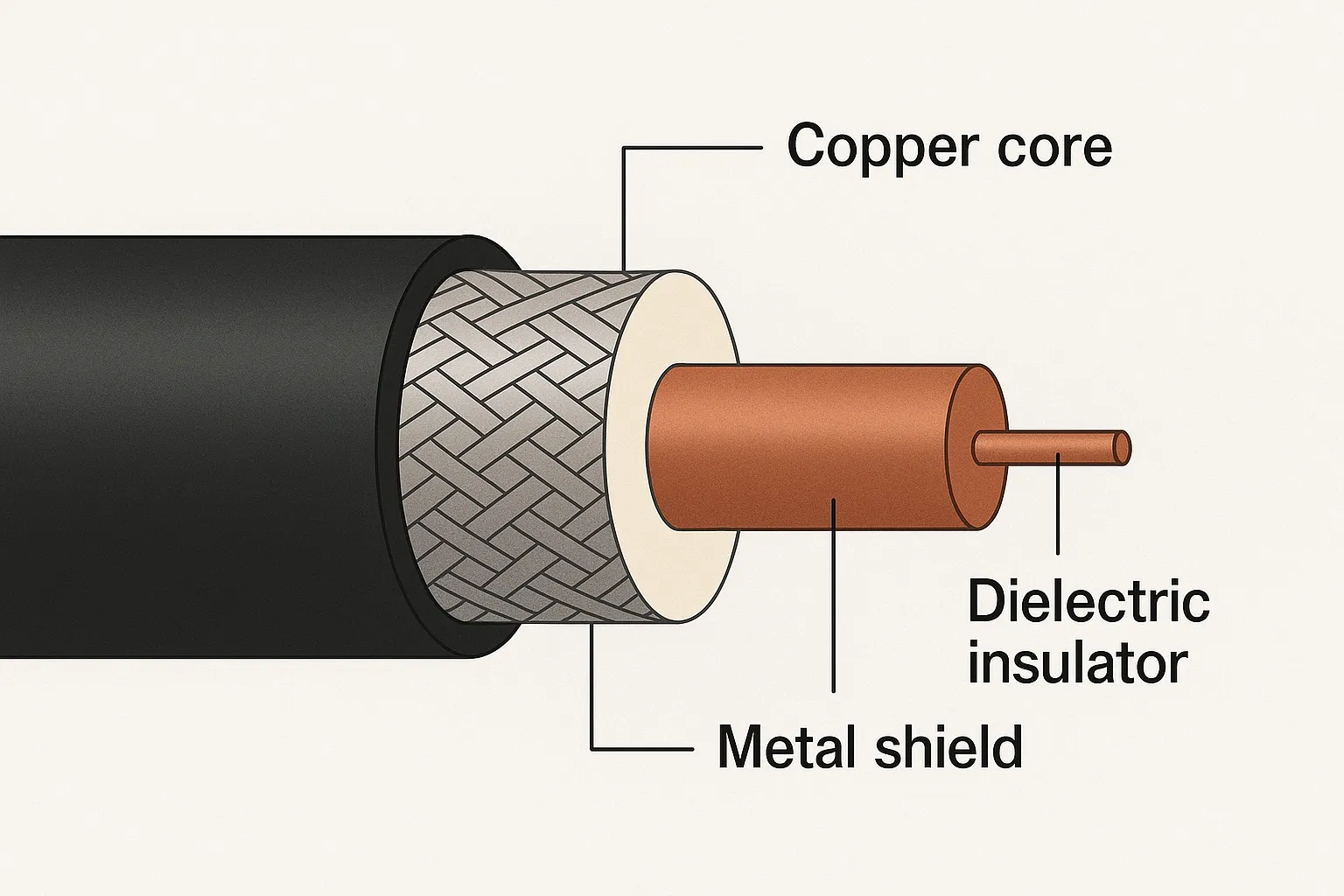
This image demonstrates the typical construction of an RF cable with a central copper conductor, dielectric insulator, braided shield, and plastic jacket—essential for minimizing signal loss and interference.
A coaxial cable (commonly called coax) is a cylindrical electrical cable where the center conductor and outer shield share the same axis—hence the term “co-axial.”
It includes four parts: a copper core, a dielectric insulator, a braided metal shield, and a plastic jacket that holds everything together.
This structure allows it to carry high-frequency RF signals with minimal loss, while resisting electromagnetic interference (EMI).
You’ll see coax used in cable TV, satellite systems, modems, and radio antenna setups — basically, anywhere clean RF signal transmission is critical.
Unlike Ethernet or AC power cables, coax’s shielding design is the key to its low signal loss and high transmission clarity.
Why is it called “coaxial”?
The name refers to its geometry: both the inner conductor and the outer shield are concentric, meaning they share the same axis.
This layout ensures consistent impedance and strong resistance to signal degradation.
When someone says “coax,” they’re simply shortening “coaxial cable.” And yes — they’re the same thing.
It’s pronounced “co-ax” (two syllables), like the first half of “coaxial.”
Other Names and Connectors for Coax
You may hear it referred to as RF cable, TV cable, or antenna cable depending on its use case — but they all mean coaxial cable.
These cables use special coaxial cable connectors, such as F-type (for TVs), BNC (used in testing gear), SMA (for RF modules), and N-type (for high-power RF systems).
Different devices require different interfaces — and that’s where RF adapter cables come in handy.
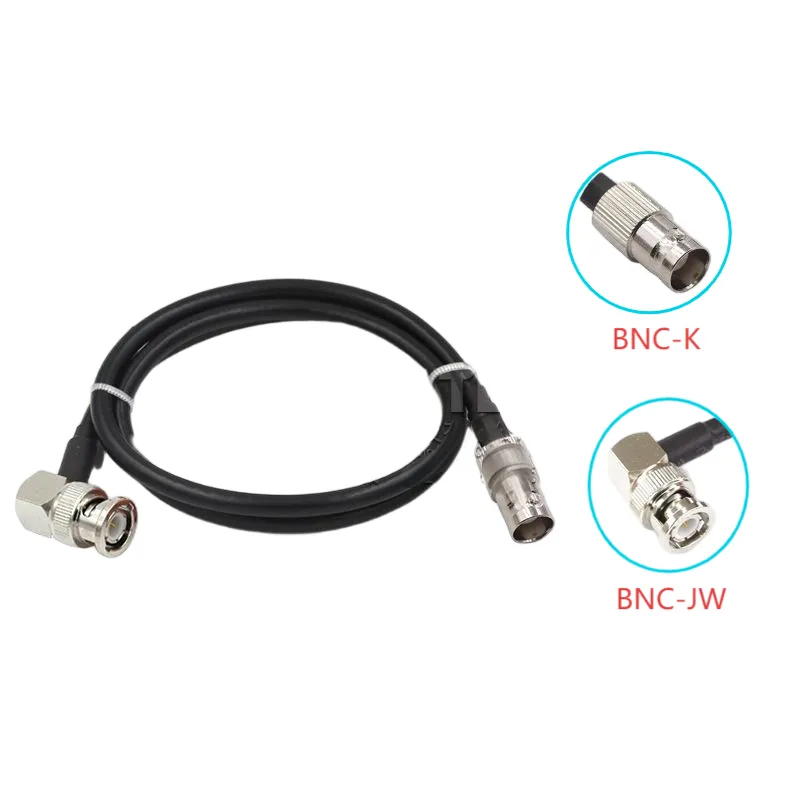
This adapter cable links an SMA male connector to a BNC female connector, typically used in lab setups to bridge compact RF modules with test instruments that use BNC interfaces.
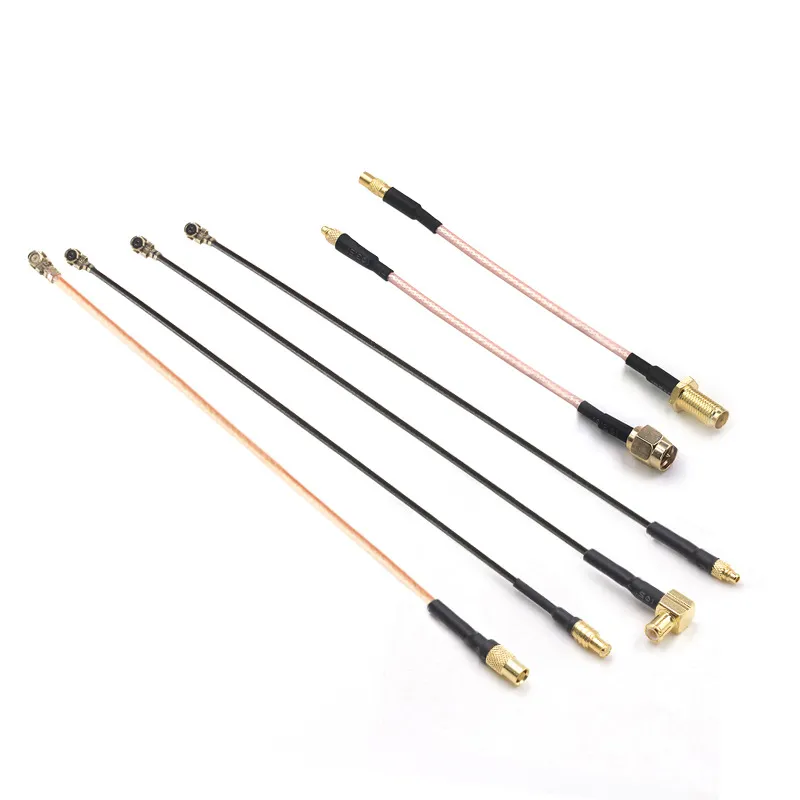
This micro RF adapter cable converts MMCX to U.FL, ideal for small form factor wireless devices. It's commonly seen in embedded designs for Wi-Fi, GPS, and LTE modules.

The N-to-SMA adapter cable bridges large, weatherproof N-type connectors used outdoors with compact SMA ports used in equipment racks or test environments.
TEJTE offers customizable RF coax assemblies such as SMA-to-BNC, MMCX-to-U.FL, or N-to-SMA — perfect for bridging mismatched radio systems.
Types of Coaxial Cables
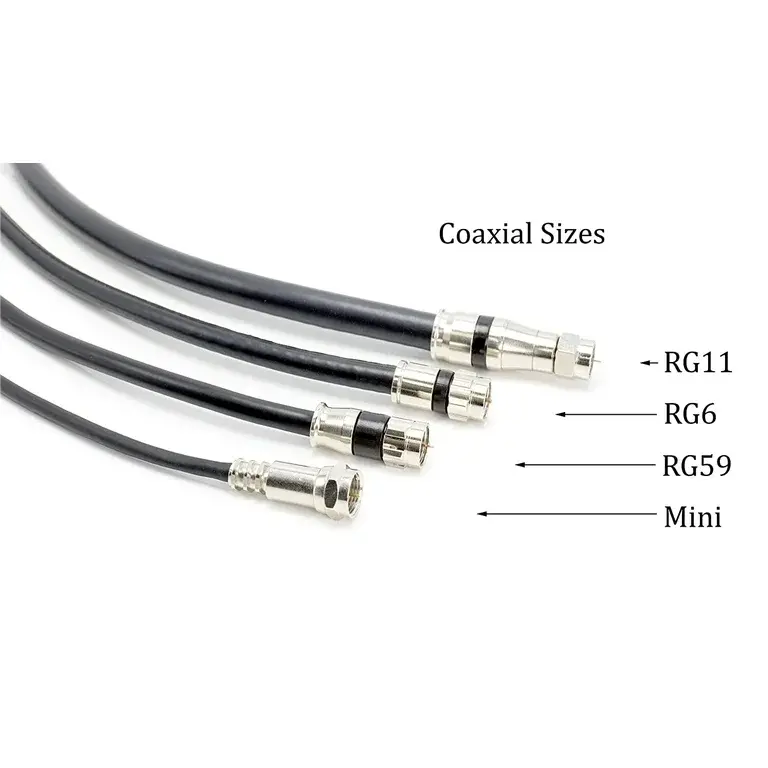
This image compares RG-59, RG-6, and RG-11 coaxial cables by thickness. RG-59 is thinner and flexible, while RG-11 is the thickest and suitable for long-distance RF transmission.
Coaxial cables come in multiple versions, each designed for different distances, frequencies, and flexibility needs.
The most commonly used are RG-59, RG-6, and RG-11 — legacy “RG” codes from military use that now identify cable grade and size.
RG-59 Coaxial Cable
RG-59 is an older, thinner coax cable with higher signal loss, making it suitable only for short-distance runs.
It was popular in analog TV setups or VCR-to-TV connections, but it’s now considered outdated.
Due to poor shielding and higher attenuation, it’s not recommended for digital or HD installations today.
RG-6 Coaxial Cable
RG-6 is the current standard coaxial cable for home use — from cable TV to broadband internet and satellite boxes.
It features a thicker center conductor and better shielding than RG-59, making it ideal for up to 150 ft.
Flexible and affordable, it’s the go-to option for most households needing reliable RF signal with minimal loss.
RG-11 Coaxial Cable
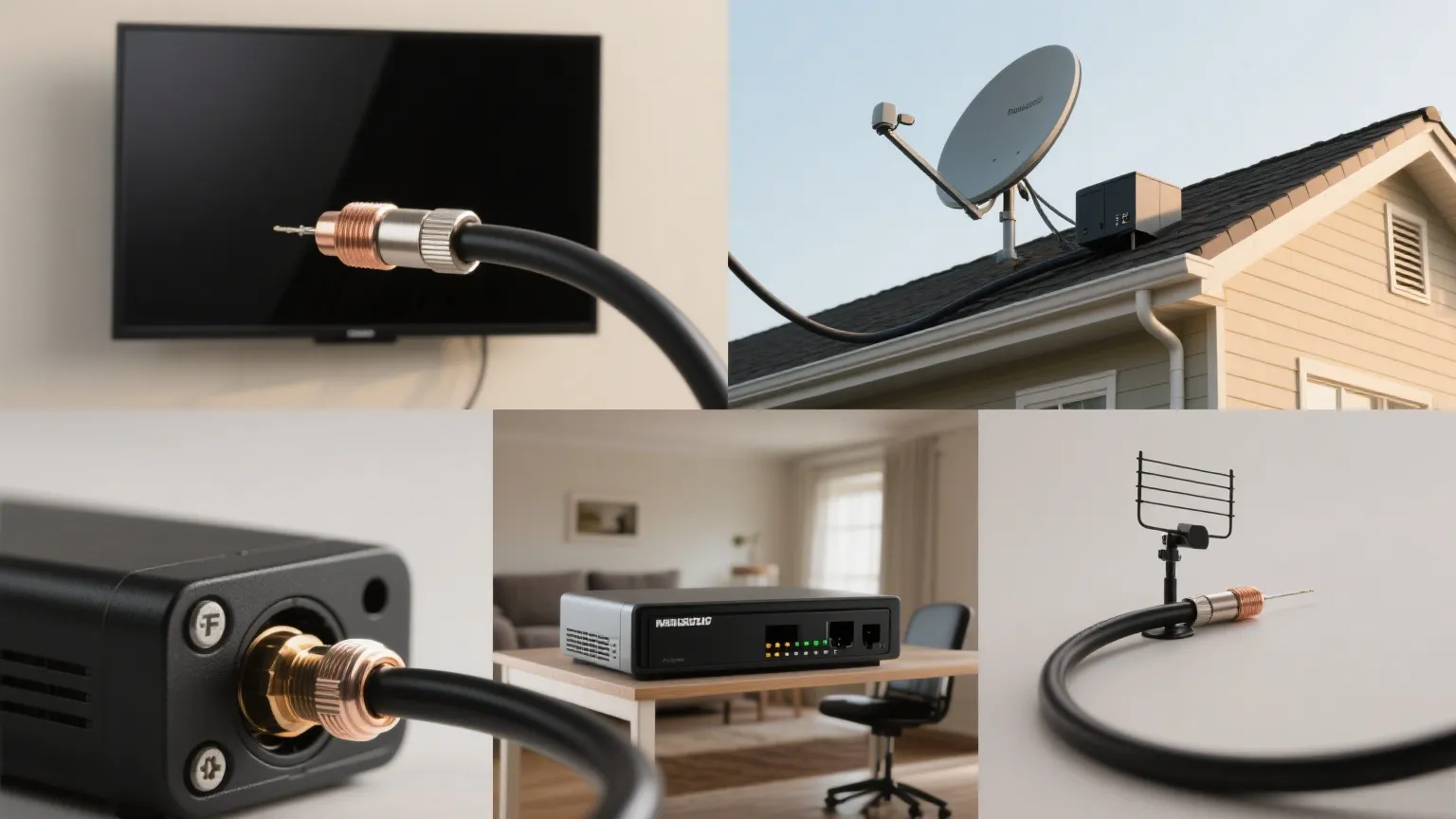
The image shows an RG11 cable being laid in a structured installation, where its low attenuation is critical for preserving signal strength across long distances.
RG-11 is a thicker, stiffer cable designed for long cable runs — often 200 ft or more.
It offers very low attenuation, making it suitable for buried outdoor lines or connections from a street pole to a home.
However, it’s expensive and hard to bend, making it impractical for indoor installations unless absolutely needed.
RG-6 vs RG-11: Which Is Better?
RG-11 technically performs better, especially over long distances, due to its lower signal loss.
But RG-6 is more cost-effective, easier to work with, and perfectly fine for typical indoor lengths.
Unless you’re wiring a campus, outdoor pole, or long-haul route, stick with RG-6 — it strikes a solid balance.
What About RG-8? Is It Like RG-11?
RG-8 is a different category: a 50-ohm coaxial cable, used mainly in ham radios, CB radios, and RF transmission.
It’s thick and handles high-power radio frequencies, unlike RG-6/59/11 which are 75-ohm and optimized for AV signals.
In short:
- RG-8 = 50Ω = radio communication
- RG-11 = 75Ω = long-range TV/internet
USB Cables and Connectors Explained
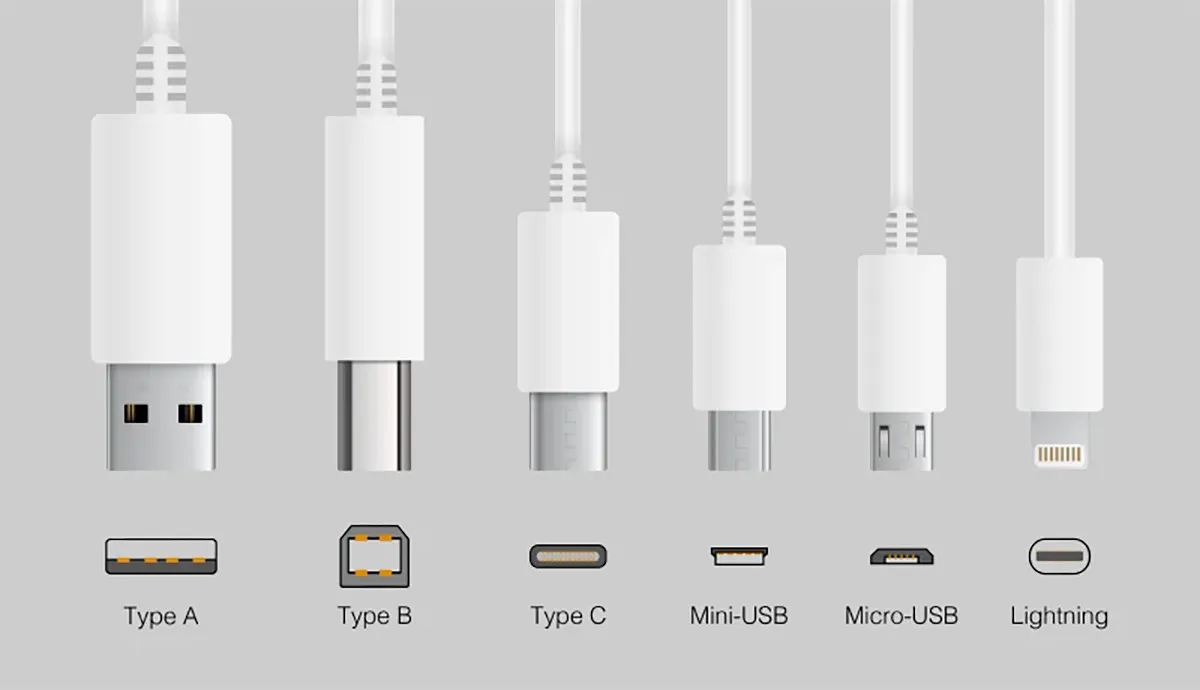
This image outlines the major USB connector formats, including legacy Mini USB, standard USB-A and USB-B, and modern USB-C with reversible design and fast data delivery.
In today’s world of computers and gadgets, USB cables are everywhere – but not all USB cables are the same. Are there different types of USB cables? Absolutely. USB cables can differ by the connector shapes on their ends and by the USB standard (which affects speed and capabilities).
There are several types of USB connectors, each with its own shape and purpose. The most common are Type-A, Type-B, and Type-C — plus some mini/micro versions of Type-B.
USB Type-A
The classic rectangular plug found on one end of almost every USB cable.
It connects to standard USB ports on computers, TVs, and wall chargers.
Used since the earliest USB 1.0 days.
One key detail: it’s not reversible — it only fits one way.
USB Type-B (and Mini/Micro variants)
Type-B is a square connector, often used on printers and external hard drives.
Most cables have Type-B on one end (device) and Type-A on the other (host computer).
Over time, Type-B shrunk into Mini-USB and Micro-USB:
- Mini-USB B: common on older cameras, MP3s.
- Micro-USB B: popular in Android phones and power banks during the 2010s.
These smaller B-types let USB reach portable devices before USB-C became standard.
USB Type-C
The newest and most versatile USB connector — also called USB-C.
It’s oval-shaped and reversible, so you can plug it in from either side (finally!).
Now seen in modern phones, laptops, tablets, and even monitors.
Capable of fast charging, high-speed data, and even video output.
One cable can do it all — USB-C is replacing all older connector types.
(Pro tip: “USB Type-C” and “USB-C” mean the same thing — the latter is just easier to say.)
USB Type B vs Type C – what’s the difference?
We now have USB Type-A, Type-B (and its Mini/Micro versions), and the newer Type-C — but how do Type-B and Type-C compare?
USB Type-B is an older, boxy connector mainly used on printers, scanners, and external drives. It’s rarely seen on new gadgets.
It’s also directional — you have to insert it the right way, and it typically connects to Type-A on the other end.
USB Type-C, on the other hand, is the modern standard for most smartphones, laptops, and tablets.
It’s reversible, much smaller, and supports multiple functions like:
- Super-fast charging (USB PD)
- High-speed data transfer (USB 3.x or 4.0)
- 4K/8K video output (via Thunderbolt/DisplayPort over USB-C)
In the past, cables were usually Type-B to Type-A. But now, USB-C to USB-C cables are common — like when charging a MacBook from a phone charger, both ends use USB-C.
In short: USB-C is better, faster, and more versatile.
Type-B is becoming a legacy connector, only found on older or industrial equipment.
USB Versions (Speeds and Standards):
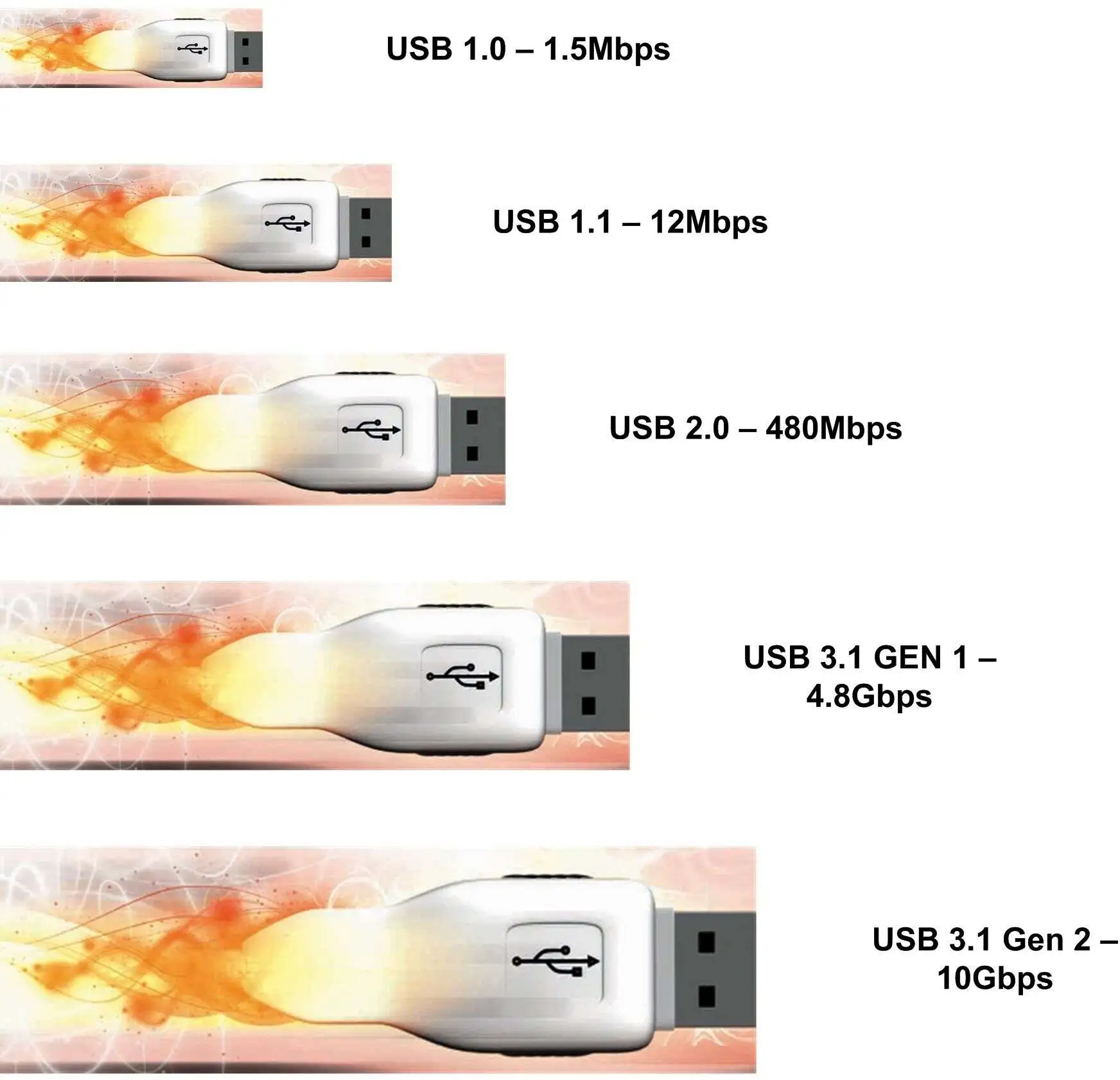
A visual comparison of USB standards highlighting speed progression from 12Mbps (USB 1.1) to over 20Gbps (USB 3.2 Gen 2x2), showing how connector types align with these protocols.
Besides different connector shapes, USB standards (like 1.1, 2.0, 3.0) define how fast data moves and how much power is delivered.
So, what’s the difference between USB 1.1, USB 2.0, and USB 3.0? The short answer: speed and capability.
USB 1.1 – Full Speed (1998)
Max data rate: 12 Mbps (megabits per second).
Designed for low-bandwidth devices like keyboards, mice, and small file transfers.
Called “Full Speed” at the time, but now far too slow for modern needs.
Essentially obsolete today — found only on ancient machines.
USB 2.0 – Hi-Speed (2000)
Boosted data rate to 480 Mbps — that’s 40x faster than USB 1.1.
Known as Hi-Speed USB, it powered the 2000s era of flash drives, printers, phone sync cables, etc.
Even now, many budget devices still use USB 2.0 due to its wide compatibility and low cost.
Still acceptable for things like mice, keyboards, and basic charging.
USB 3.0 – SuperSpeed (2008+)
Max speed: 5 Gbps — more than 10x faster than USB 2.0.
Known as SuperSpeed USB, ideal for external SSDs, fast backups, and HD media.
Also supports more power delivery.
USB 3.0 ports often have blue plastic inside — a visual trick to tell them apart.
A USB 3.0 Type-A plug looks like 2.0, but has extra pins and is backward compatible.
Compatibility Tip:
All newer USB versions are backward compatible:
- Plug a USB 2.0 device into a USB 3.0 port — it still works (at 2.0 speed).
- Same goes for USB 3.1 / 3.2 / USB4 — they all support older devices.
- You just won’t get the higher speed unless both port and cable support it.
How to tell if a USB cable is 3.0 or 2.0?
Not sure whether your USB cable supports USB 3.0 speeds? There are a few simple ways to check:
1. Check the Color
- Many USB 3.x ports and plugs use a blue plastic insert inside the connector.
- On a PC or charger, if the USB port has a blue interior, that’s a 3.0 indicator.
- Same goes for cables — peek inside the Type-A plug, and if the plastic tab is blue, it’s likely USB 3.0.
2. Look for Labels
- USB 3.0 cables and ports often have “SS” printed on them, meaning SuperSpeed.
- You might also see the USB trident logo with a small “3.0” next to it.
3. Count the Pins (If You Can)
- USB 3.0 connectors have extra pins compared to USB 2.0.
- A USB 3.0 Type-B plug is bigger and often blue — used in external drives or printers.
- Micro USB 3.0 connectors (on some hard drives) are wider and look like a double plug — unmistakable.
Final Tip:
If your cable is plain black with no markings, it’s probably USB 2.0.
But remember: even a USB 3.0 cable won’t boost speed unless your device also supports USB 3.0.
For example, plugging an old USB 2.0 flash drive into a blue port doesn’t magically make it faster — both cable and device must support the same standard.
Summary: What You’ve Learned
- USB connectors come in A, B, C shapes, and versions like 1.1, 2.0, 3.0.
- Newer cables (especially USB-C) support faster speeds and more functions.
- Picking the right USB cable means checking both ends: type + version.
- Know what you’re plugging in — it avoids confusion and slow speeds.
Side note: Yes, there are other types like Lightning (Apple) and IEEE 1394 FireWire, but this guide focused on what you’ll encounter most often — standard USB cables.
Jumper Cables: Proper Order to Jump-Start a Car
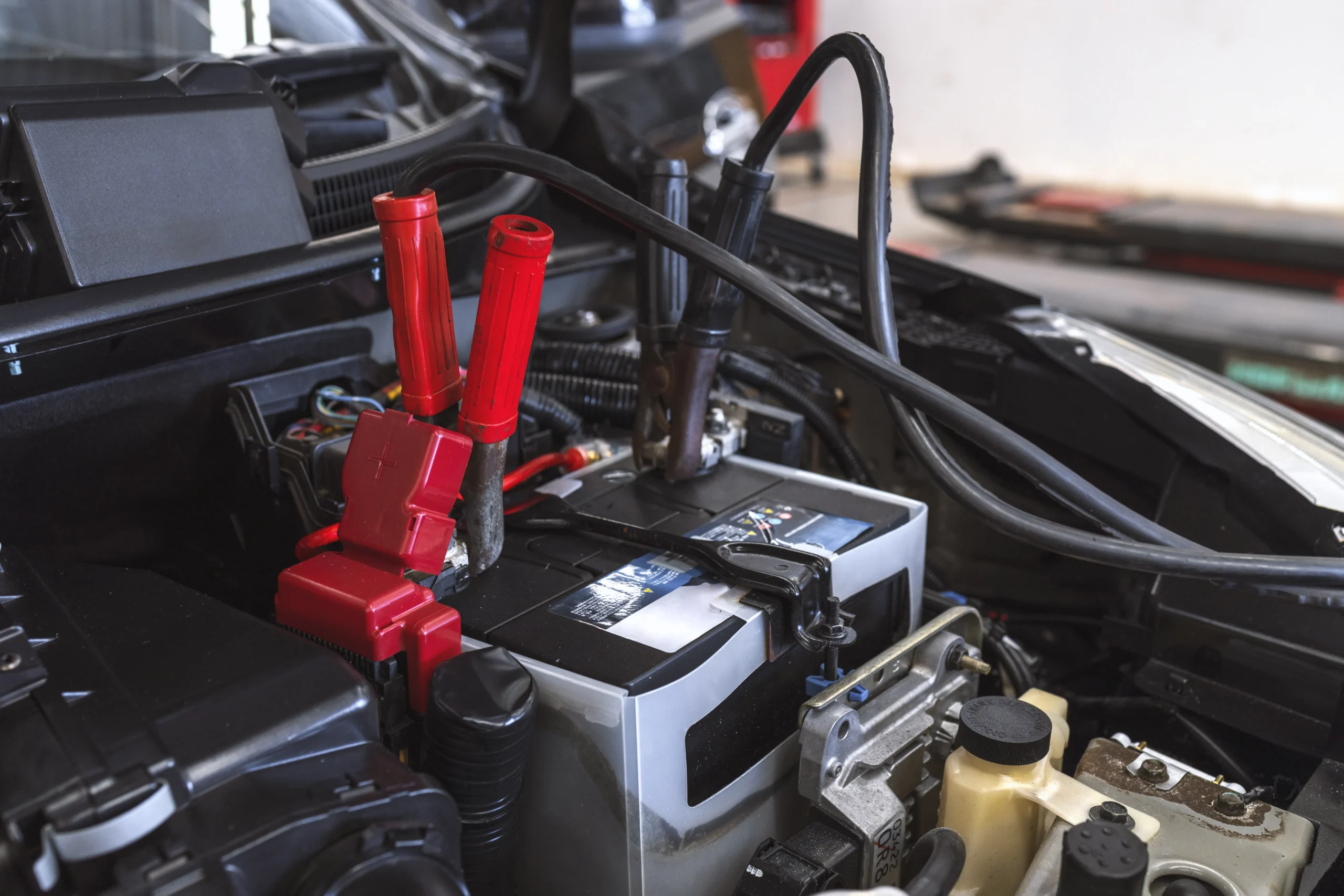
This diagram outlines the recommended step-by-step jumper cable hookup: positive-to-positive, then negative-to-chassis ground, reducing the risk of short circuits during jump-start.
Ever had to deal with a dead car battery? Then you’ve likely reached for jumper cables — those thick, red-and-black wires that bring your car back to life.
But if you’ve never used them before, you may ask: Does the order matter? Spoiler: Yes, it really does.
The Correct Jumper Cable Connection Order
To safely jump-start a car, follow this step-by-step sequence:
- Red to Dead — Connect the red clamp to the positive (+) terminal on the dead battery.
- Red to Donor — Connect the other red clamp to the positive terminal on the booster (donor) car.
- Black to Donor — Attach a black clamp to the negative (–) terminal of the good battery.
- Black to Metal — Connect the final black clamp to a bare metal surface on the dead car’s engine (like a bolt or bracket). Do NOT connect it to the negative post on the dead battery.
Mnemonic to remember:
“Red to dead, red to donor, black to donor, black to metal.”
What Comes Off First?
When disconnecting, just reverse the order:
- Black from the metal ground (dead car)
- Black from the donor battery
- Red from the donor battery
- Red from the formerly dead battery
Removing the ground first helps prevent accidental sparks or short circuits.
Why Does the Order Matter?
You might get lucky doing it backwards, but it’s risky.
- If you connect the negative cables first, a stray spark could ignite battery gases.
- If a clamp slips and hits metal, you might short the circuit or damage the ECU.
- Worst case? Personal injury or fried electronics.
Using the correct order makes all the difference — and costs nothing extra.
Final Safety Tips
- Always turn both car ignitions OFF before connecting.
- Keep metal clamps from touching each other.
- After a jump-start, let the revived car run 10–20 minutes to recharge.
- If it won’t hold the charge, the battery or alternator may need replacing.
Pro tip: When searching “Which jumper cable goes first?” — the answer is always: Red on the dead battery’s positive terminal.
And when grounding the black cable, always use unpainted metal, not the battery itself.
Zip Ties for Cable Management

This image showcases common cable management methods including velcro wraps, zip ties, and cable sleeves to avoid clutter, enhance airflow, and reduce hazards in setups.
Tired of tangled cables behind your desk or inside your car’s engine bay? Meet your best friend: the humble zip tie — also called a cable tie.
Are zip ties and cable ties the same?
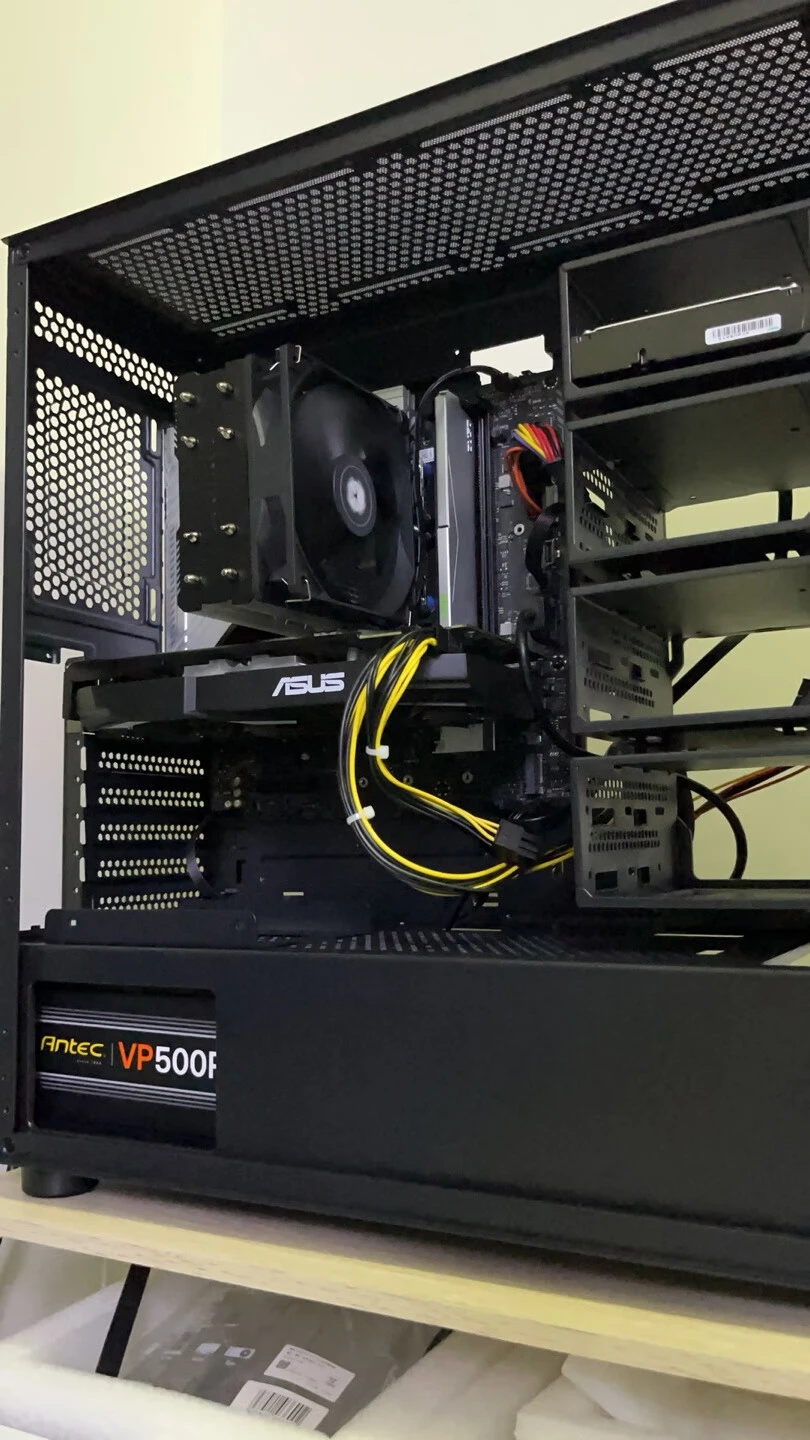
The graphic presents different kinds of cable ties used in wire bundling: standard nylon ties, reusable types, and UV-resistant models suited for outdoor use.
Yes — zip tie is just a casual name. It’s called that because of the “zip” sound it makes when you tighten it.
The formal term is cable tie, and they both refer to the same thing: a locking nylon strap used to bundle wires.
What sizes and materials do zip ties come in?
Common sizes:
- 100mm (4 inch) — best for electronics or small cable groups
- 300mm (12 inch) — great for thicker cables or even garden hose bundling
Materials:
- Nylon: Flexible, cheap, good for most indoor uses
- Black zip ties: UV-resistant, ideal for outdoor use
- Metal zip ties: Heat-resistant stainless steel, used in automotive or industrial settings
They’re available at Home Depot, Amazon, or any hardware store — sold in bulk packs (often 100+ per bag).
How do you use a zip tie?
Super easy:
- Bundle the cables.
- Wrap the zip tie around.
- Insert the pointed end into the locking head.
- Pull it tight — you’ll hear that “zip” click.
- Trim the excess with scissors or flush cutters.
Don’t overtighten! You risk damaging the cables, especially for fiber optics or soft tubing.
Can you undo a zip tie?
Normally, no — standard zip ties are single-use. To remove, you cut it.
However, there are reusable zip ties with a release tab.
If you must reuse a standard one, you might try prying the tab inside with a pin or mini screwdriver — tricky but possible.
Is it safe to zip tie power cables?
Yes — with a few tips:
- Don’t tighten too much around power or high-current wires, as they may heat up.
- In plenum-rated spaces, use fire-resistant cable ties per code.
- For bundles of power wires, leave some airflow to avoid heat buildup.
If you need to adjust cables often, Velcro straps might be a better pick. But for permanent setups, zip ties are unbeatable in price and simplicity.
Final Word: Keep it neat, keep it safe
Zip ties are cheap, reliable, and effective — just don’t rip them by hand and trim the tail cleanly (the ends can be sharp).
You can get colored zip ties for organization, or black heavy-duty ones for outdoor gear.
Common searches like “Zip Ties Amazon” or “black zip ties Home Depot” show how popular they are — stock up and you’ll use them everywhere, not just for cables!
FAQ: Your Cable Questions Answered
1. What are the three types of coaxial cable?
The three most common coaxial cable types are RG-59, RG-6, and RG-11. RG-6 is the current standard for home use, while RG-11 offers lower signal loss for long runs. RG-59 is largely outdated. These coaxial cable cables vary in thickness, shielding, and ideal use cases.
2. Which is better, RG-6 or RG11 coaxial cable?
RG-11 coaxial cable has better performance over long distances due to lower signal loss. However, RG-6 is more flexible and ideal for typical home applications. So, RG-6 is better for short runs, while RG-11 is better for outdoor or long-distance coaxial cable installations.
3. What is the difference between a coaxial cable and a normal cable?
A coaxial cable is shielded and designed for high-frequency signal transmission, often used in RF applications. “Normal” cables (like power cords or Ethernet) serve different purposes and lack the coaxial cable coaxial layered shielding that prevents interference.
4. How can I tell if my USB cable is 3.0 or 2.0?
Look for a blue plastic tab inside the connector or “SS” (SuperSpeed) markings. USB 3.0 cables also have more internal pins. For quick data transfer, choose from newer USB cable types like USB 3.0 or USB-C. Older USB 2.0 cables typically have black connectors.
5. What is USB Type B and USB Type C?
USB Type-B is a square-shaped plug often used in printers. USB Type-C is a newer, oval, reversible connector used in phones, laptops, and modern accessories. It supports higher power delivery, faster speeds, and more functions than Type-B.
6. What’s the correct jumper cable order when jump-starting a car?
The safe jumper cable order is:
Red clamp to dead battery’s positive
Red to donor battery’s positive
Black to donor’s negative
Black to metal ground on the dead car
This sequence prevents sparking and protects both batteries.
7. Which jumper cable comes off first?
Disconnect the black clamp from the metal frame of the dead car first, then remove the remaining cables in reverse order. Safety is key. Many people Google things like “jumper cable order reddit” – now you have the definitive answer.
8. What is the difference between a zip tie and a cable tie?
There’s no real difference. “Zip tie” is a casual term; “cable tie” is the formal one. You can find both listed online as cable tie zip products. They’re great for bundling cables but avoid overtightening, especially on power cords.
9. Can I reuse cable ties?
Most zip ties are single-use, but releasable cable ties exist. They have tabs to unlock them. If you tie cables often, you might consider reusable Velcro straps as an alternative to constantly cutting off standard ties.
10. Where can I buy zip ties for cable management?
Cable ties are widely available – from Home Depot’s black zip ties to bulk packs on Amazon. Popular sizes include 100mm, 200mm, and 300mm, depending on your bundling needs.
Conclusion
From coaxial cable cables in your TV setup to USB cords, jumper cables, and cable tie zip organizers behind your desk — these wires form the unseen grid of our digital lives.
Each one serves a purpose, and knowing which to use – and how to use it properly – is crucial.
Knowing whether you need RG-6 or RG-11, understanding USB Type-C vs Type-B, or even choosing the correct coaxial cable coaxial connector can save time, reduce troubleshooting, and prevent costly mistakes.
It’s not just techy talk – it’s the real-life difference between clarity and chaos.
Tejte: Your Partner for RF Cable Solutions
Working on antennas, routers, or wireless projects?
Tejte provides:
- Custom-made coaxial cable assemblies
- Certified coaxial cable coaxial connectors
- Interface-matched RF adapter cables
- And yes – everything from SMA, BNC, N-type to MMCX/U.FL, delivered with quality assurance
We help you navigate cable types that power high-frequency systems with precision.
Final Note
So whether you’re reviving a car, managing USB peripherals, or cleaning up messy wiring with a cable tie zip kit — the right cables (and connectors) matter.
Stay organized, stay safe, and most importantly: stay connected.
And if it’s RF-related, Tejte has your back with quality components built to perform.
Bonfon Office Building, Longgang District, Shenzhen City, Guangdong Province, China

A China-based OEM/ODM RF communications supplier
Table of Contents
Owning your OEM/ODM/Private Label for Electronic Devices andComponents is now easier than ever.
